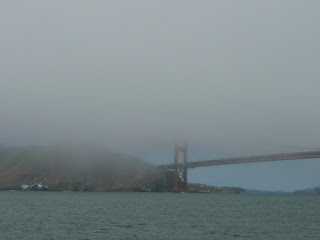We checked the weather from various sources and saw that the
coastal winds were easing but the swell from a storm further north was 3-4
metres high. We decided to wait a little longer and leave San Luis Obispo (SLO)
at 0300 on Thursday 22nd June.
 |
| At last the fog clears and we can see San Pedro Point |
We left in the dark in thick fog. The lights on the piers
were shrouded in a veil but at least they were visible. The radar was on. It
detected something close by, which turned out to be an anchored fishing vessel
with no lights. By 0600 it was light but visibility was still less than half a
mile. The big ships had to be in the offshore Traffic Separation Scheme (TSS),
recreational boats would be mad(!) to be out in such conditions so our main
concern was fishing vessels.
 |
| Uh oh! The fog's out to get us again |
Around midday the fog lifted giving us about 2 miles
visibility for a short time before closing in again. The wind began to blow
gently from the SE, as predicted. The flapping mainsail filled, the current was
with us and we started to make good speed with a following sea and big swell.
It was cold and damp all day and night. On Friday morning the visibility
cleared as the fog became patchy. We creamed along at over 6 knots with the
rare following winds reaching 20 knots. We saw fishing pots and touched one
before the fog closed in again.
 |
| Our first glimpse of a bridge |
We were going to stop at Half Moon Bay to wait for the right
tide at the Golden Gate Bridge, just over 20 miles north. Jeremy worked out
that if we kept going and averaged 6 knots or more (we usually average 5 knots)
we’d catch the last of the flood tide into San Francisco Bay. We went for it.
Sal Darago was amazing. The fog swirled in and out giving us glimpses of the
coastline, which was rocky and inhospitable. A whale blew and dived just off
the port bow.
 |
| It's red, not gold. Have we come to the right place? |
At 1335 on Friday 23rd June, we sailed under the
Golden Gate Bridge. It was shrouded in fog and the fog horn was sounding
non-stop. It was an exciting moment and we were elated.
 |
| That must be Fort Point under the arch |
Then we were in San Francisco Bay, watching the fog lift off
the waterfront, noting a misty Alcatraz Island on our port side. Surely, we
were in a film. It felt surreal. We had to concentrate, keep our course, be
aware of vessels of all sizes and head for the anchorage at Aquatic Park Cove,
next to the Maritime Museum.
 |
| Another first for an elderly Westerly and her crew |
The sign on the wall said “Watch Out for Swimmers”. We were
surprised that we were allowed to anchor in a place where people could swim
near the boats and we were shocked to see most of the swimmers were not wearing
wet suits in water that was much colder than in Mull. Another sign told us that
we must ring up for permission to stay overnight and the maximum length of stay
was 72 hours. There was a bit of a glitch in the exchange of text messages, but
we were given permission and there was no charge.
 |
| Four pelicans and the Palace of Fine Arts behind |
Jeremy informed Customs and Border Patrol of our whereabouts
and intentions and booked two nights at Redwood City Marina in the south of the
Bay, only 20 minutes’ drive from Simon and Erin’s apartment. We arranged to meet Simon and Erin on the
beach on Saturday evening. They would come up by train and sail to Redwood City
Marina with us on Sunday.
 |
| San Francisco skyline |
That evening we celebrated our arrival with sundowners in
our chilly, sunless cockpit wearing jogging bottoms, fleeces and woolly hats.
Swimmers came past wearing only swimwear and goggles! They were from the
Dolphin Swimming and Boating Club, which was next to the impressive Art Deco
Maritime Museum building on the beachfront. The city of San Francisco rose up
behind them. We were here, after sailing 10,655 miles from the River Deben.
Well done, Sal Darago.
 |
| The Maritme Museum in Aquatic Park Cove. Can you spot SD? |

























